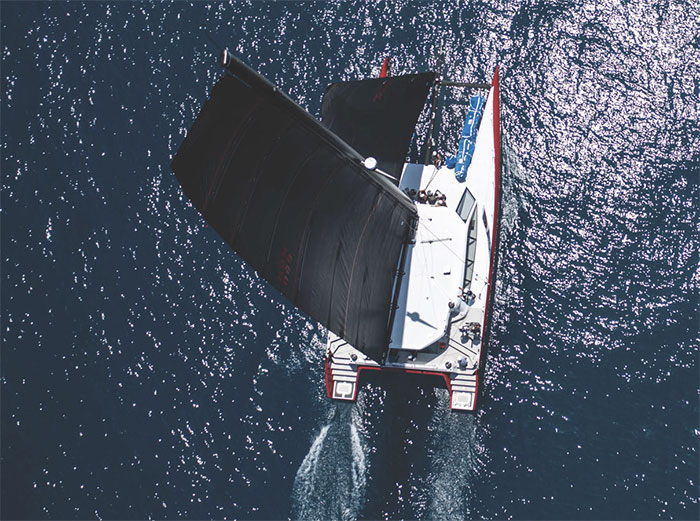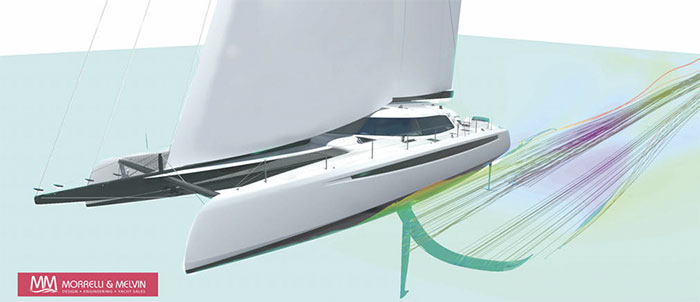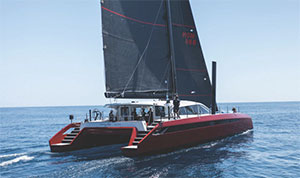

The new generation of large, high-performance luxury cruising catamarans are making great use of the latest developments in AC rig technology
You simply can’t miss them, big cats on the prowl. Their numbers have exploded in recent years as the market for luxury multihulls grows by the season. But this is far more than the product of a new trend. The rapid development of the modern performance cruiser cat scene is feeding off some of the latest and most advanced technology at the sharp end of the sport where it nurtures fast, easily driven boats that are comfortable and easy to handle. Essential to this impressive growth is a new breed of sail plans and rigs where Southern Spars is at its centre.
‘One of the big key differences with this new generation of boats is that they sail off apparent wind most of the time,’ says Southern Spars co-founder and director Mark Hauser. ‘This means that they build their apparent wind very quickly as they accelerate which means that the sail shapes need to change to match. In the past, rigid masts restricted the amount of bend you could achieve to help this change in shape. But today, not only can the rigs change shape, but they work in conjunction with the structured luff mainsails to allow the sail to be flattened off quickly and efficiently as the apparent wind speed builds and the angle reduces. Typically, these boats can be starting at five to seven knots and accelerating to 15-20kts in very little time, so you have to switch through the gears pretty quickly. A lot of the time the cunningham is the key control for making significant sail shape adjustments. It also makes it much easier to produce a set of trimming notes that are easy to follow and effective, especially when sailing shorthanded. So, like adding gears to a gearbox, this gives a much wider range to the sail plan.’
For designers, the way that the rig and sail plan interact and the control systems that make this possible has taken them into new areas.
‘From a large cruising cat design and engineering point of view, being able to power up the mainsail more effectively with a structured luff main coupled with a diamond spreader mast was a combination that didn’t exist before the last America’s Cup,’ says sales engineer Jarrard Wallace. ‘With cunningham tension, the structured luff allows the sail to move forwards at its leading edge while the internal structure of the mast is designed to match the shape that the sail has been designed to take. Traditionally, the cunningham would simply drag the draft forward a bit. Today, the control is far more sophisticated and effective. Diamond spreaders allow us to achieve a more predictable sailing bend range. They also allow us to use smaller, lighter mast tubes. Plus, we have the ability to change the set-up of the mast and its characteristics with the internal mast jacks which allow us to pre-tension the diamond stays.

The Persico 72 is likely to be the first of many large, foiling cruising cats that will have a major influence on rig design in the near future.
‘Trying to pre-load the rig in place in the yacht using halyards and then putting spanners on turnbuckles just doesn't get you there. Instead, an internal jack achieves this with relatively low effort and provides the accuracy to know how much tension you have in the diamonds. It means we can target preload and prebend measurements which also means that when we get both of those things together, we know that the diamond tension is spot on and we're ready to go.’
Such technology and techniques are of course well known in the racing world where at the very leading edge, the America’s Cup has been an important driver. But, modern multihulls are bringing their own set of conditions and requirements into the mix. Righting moment is one particular area where multihulls by definition can generate very high loads and the power that goes with it. But now the development in foils on multihulls is taking the power game onto yet another level.
‘We are currently working on the Persico 72, a 72ft performance cruising cat that is fully foiling, and this looks set to be just the start,’ says Hauser. ‘While not everyone will want to head down this route, it is clear to us that we will be needing to work in this area more and more as foiling becomes the norm and where the speeds take another step up. Even just from an aerodynamic point of view the greater speed thanks to foils has a big knock-on effect for our design and engineering.’ Indeed, the integration of the complete rig package with the rest of the boat will be influenced as Wallace explains.
‘The Persico 72 project was a good example of the collaboration that’s required. One of the key decisions was where to put the forestay. Given the size and proportions of the desired sail plan, the balancing act involved establishing the right place so that the mast bends where it needs to, but at the same time supports the various configurations of foresails while still achieving the lightest solution. Sometimes knowing where the forestay needs to go from the sails’ point of view will lead to a heavy topmast which is clearly not desirable. So, being involved at an early stage allowed us to work with the entire team to achieve a lighter overall package while still achieving the original design objectives.’
An area of required development that is less obvious, but can have big implications, is in providing accurate loads for designers and other equipment manufacturers.

Above: the overall weight of Highland Fling’s rig package was significantly reduced by bringing Southern Spars into the design loop at an early stage
‘Producing accurate load mapping is really important for the overall design,’ said Wallace. ‘From the total amount of mast compression, to the amount of torque that is required to rotate the mast on the ball, these are key factors that feed into making the rig easy and safe to handle, especially for small crew numbers.
‘If the boat has a rotating rig there is another level of detail that is crucial when it comes routeing control lines from the mast into the deck superstructure.’
A bi-product of modern multihulls is that their stability and structural rigidity along with high loads can sometimes make it difficult to assess just how loaded the boat is.
‘Because multihulls don’t heel like a monohull, knowing when loads are building and getting close to their peak can be quite difficult,’ says Hauser. ‘The risk is that loads can go through the roof quickly, so load monitoring is a big part of these powerful new boats. Load cell monitoring systems have become increasingly important and the Synapse system developed together with Future Fibres has taken this onto another level by accurately measuring and recording the loads as the rig, rigging and boat are seeing them.
‘This allows the North Design Services software to compare the designed loads with those that are being experienced across a full range of real-world conditions. From here we can set limits and red lines along with being able to create accurate tuning guides.’
A good example of the latter in operation came with a recent rig installation.
‘The recent Highland Fling 80 rig was stepped in a day and the boat was sailing the next day. From arriving on the dock, to dressing, stepping and sailing was less than 36 hours,’ says Hauser.
‘One of the big advantages we have throughout the process from concept to delivery is that within the North Technology Group we have the mastmaker, the rigging supplier and the sailmaker all working together. Given just how sophisticated, refined and complex the process now is I honestly don’t know how you would do it without that kind of group.’
Click here for more information on Southern Spars »
We invite you to read on and find out for yourself why Seahorse is the most highly-rated source in the world for anyone who is serious about their racing.
To read on simply SIGN up NOW
Take advantage of our very best subscription offer or order a single copy of this issue of Seahorse.
Online at:
www.seahorse.co.uk/shop and use the code TECH20
Or for iPad simply download the Seahorse App at the iTunes store


